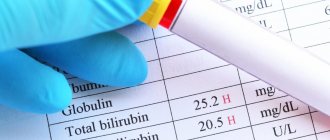Detailed description of the study
Protein fractions are separate types of blood proteins: albumin, alpha1-, alpha2-, beta- and gamma globulins. Their study is used as an additional test in the diagnosis of many diseases.
Quantitative relationships between individual serum proteins are of important diagnostic importance To separate all serum proteins, an electrophoresis method is used, based on the different mobility of serum proteins in an electric field. Using electrophoresis, proteins are divided into the following fractions: albumins and globulin fractions (alpha1-globulins, alpha2-globulins, beta-globulins and gamma-globulins):
1. Alpha1-globulins: alpha1-antitrypsin, alpha1-acid glycoprotein, alpha-1 lipoprotein. 2. Alpha2-globulins: alpha2-macroglobulin, haptoglobin, apolipoproteins, ceruloplasmin. 3. Beta globulins: transferrin, C3 component of the complement system, beta lipoproteins, hemopexin. 4. Gamma globulins: immunoglobulins - IgA, IgM, IgG.
As a result of the development of acute or exacerbation of chronic inflammatory diseases, the ratio of protein fractions changes. A decrease in the amount of one or another type of protein is observed in immunodeficiencies, which indicate serious processes in the body (autoimmune diseases, HIV, oncology, etc.). An excess of one type of protein or another indicates monoclonal gammopathy (production of abnormal types of immunoglobulins). The consequences of gammopathy include multiple myeloma (plasma cell cancer), Waldenström's macroglobulinemia (bone marrow tumor), etc.
The study of protein fractions is more diagnostically informative than the determination of only total protein or albumin. In many diseases, the percentage of protein fractions often changes, although the total protein content in the blood serum remains within normal limits. In some diseases, proteins appear in the blood that differ physically, chemically and immunologically from ordinary serum proteins. They are called monoclonal immunoglobulins (paraproteins, M-proteins). When performing electrophoresis of blood serum proteins, the presence of paraproteins is indicated by the appearance on the electropherogram of an additional (absent in healthy people) narrow and sharply limited fraction of proteins (also called the M-gradient) in the region of gamma globulins. Detection of paraproteins is most typical for paraproteinemic hemoblastoses (myeloma, Waldenström's macroglobulinemia, heavy chain disease), less common in chronic hepatitis, and in some elderly patients. High concentrations of C-reactive protein and fibrinogen can mimic M protein. An increase in alpha-1- and alpha-2-globulins can be observed in acute and exacerbations of chronic inflammatory processes, in diffuse connective tissue diseases (systemic lupus erythematosus, rheumatism, rheumatoid arthritis, etc.), malignant tumors, some kidney diseases occurring with nephrotic syndrome (glomerulonephritis, amyloidosis, etc.).
A decrease in the level of alpha-2-globulins can be observed in chronic pancreatitis, diabetes mellitus, and less commonly in toxic hepatitis. An increase in the content of beta globulins most often occurs in people with lipid (fat) metabolism disorders, including patients with atherosclerosis, coronary heart disease, and hypertension.
A decrease in beta globulins is less common and is usually due to a general deficiency of plasma proteins.
An increase in the amount of gamma globulins , which are the main “suppliers” of antibodies, is often observed in chronic liver diseases (chronic hepatitis, cirrhosis), chronic infections, some autoimmune diseases (rheumatoid arthritis, chronic autoimmune hepatitis, etc.), myeloma.
A decrease in gamma globulins in the blood occurs normally in children aged 3-4 months (physiological decrease), and in adults it is always pathological in nature and usually indicates congenital or acquired immunodeficiency conditions, often observed with systemic lupus erythematosus.
What is globulin?
Globulin is a blood protein important for regulating the functioning of our bodies. Why are globulins needed?
Main functions:
- transport hormones, vitamins and other substances;
- protect the body from viruses, bacteria, toxins, foreign proteins, producing antibodies against them;
- regulate blood clotting;
- bind sex hormones, drugs, carbohydrates and other substances.
The amount of globulins may deviate from the norm in the following cases:
- inflammatory process;
- disturbances in the functioning of the liver, kidneys, lungs, endocrine system;
- hormonal changes;
- physical or chemical damage to organs;
- cancer;
- HIV infection;
- advanced age (in men the concentration of globulins may be increased).
The amount of globulins is regulated by sex hormones: estrogens increase their level, androgens decrease them. Accordingly, women contain more blood globulins than men.
Sex hormone binding globulin
The liver produces most of the blood proteins, including SHBG - sex hormone binding globulin. For the body to function properly, some of the hormones must be bound. The bound hormone is inactive, while the free one is active and performs all its functions. By binding “extra” hormones, protein limits their effect on the body.
SHBG binds progesterone, estradiol, testosterone, androstenedione, 5-dihydrotestosterone. When the amount of SHBG decreases, the concentration of active (free, unbound) hormones increases. With increased amounts of unbound sex hormones, irregular menstrual cycles and facial hair growth (in women), breast enlargement (in men) and other effects may occur.
If you suspect that your globulin is high or low, consult your doctor. He will write a referral for a SHBG analysis. Women can take it on any day of the menstrual cycle.
SHBG: normal
In women of reproductive age, sex hormone binding globulin should be in a concentration of 26.1–110.0 nmol/l.
In postmenopausal women, 14.1–68.9 nmol/l.
In men, their level should be in the range of 14.5–48.4 nmol/l.
Globulin is elevated - possible reasons:
- increased amount of estrogens;
- dysfunction of the endocrine system;
- hepatitis;
- HIV infection;
- taking oral contraceptives.
Reduced SHBG levels are promoted by:
- increased levels of hormones (testosterone, cortisol, prolactin);
- gigantism;
- polycystic ovary syndrome;
- cirrhosis of the liver;
- nephrotic syndrome;
- insufficient amounts of thyroid hormones;
- syndrome of insufficient cellular sensitivity to insulin.
Globulins are a group of proteins that includes several subgroups: alpha 1, alpha 2, beta and gamma. Their number fluctuates during illnesses.
| Body condition | Fractions (groups) of globulins | Examples of diseases | |||
| Alpha-1 | Alpha-2 | Beta | Gamma | ||
| Acute inflammatory processes | ↑ | ↑ | — | ↑ | Acute viral and bacterial diseases, myocardial infarction, early stages of pneumonia, acute polyarthritis, tuberculosis (exudative) |
| Chronic inflammatory processes | — | ↑↑ | — | ↑↑ | Cholecystitis, pyelitis, cystitis, late stages of pneumonia, chronic tuberculosis and endocarditis |
| Renal dysfunction | — | ↑ | ↑ | ↓ | Nephritis, toxicosis during pregnancy, tuberculosis (terminal stages), nephrosclerosis, nephritis, cachexia |
| Malignant neoplasms | ↑↑ | ↑↑ | ↑↑↑ | ↑↑ | Tumors in various organs with metastases |
| Hepatitis | — | — | ↑ | ↑↑ | Liver poisoning, hepatitis, leukemia, oncology of the lymphatic and hematopoietic apparatus, dermatosis, polyarthritis (some forms) |
| Liver necrosis | — | ↓ | ↑ | ↑↑ | Severe forms of tuberculosis, chronic polyarthritis and collagenosis, liver cirrhosis |
| Jaundice (mechanical) | — | ↑ | ↑ | ↑ | Cancer of the biliary tract and head of the pancreas, as well as obstructive jaundice |
↑ - means that the concentration is increasing
↓—means that the concentration decreases
Alpha globulins
Alpha globulins are divided into two categories: alpha 1 globulins and alpha 2 globulins.
Alpha-1-globulins: normal
The normal level of alpha-1-globulins is 3–6%, or 1–3 g/l.
Among alpha-1-globulins there are:
- alpha-1 antitrypsin;
- alpha-1 lipoprotein;
- alpha-1-glycoprotein;
- alpha-1-fetoprotein;
- alpha-1-antichymotrypsin.
These substances are also called acute phase proteins: they are produced in increased quantities during various organ damage (chemical or physical), during viral and bacterial infections. They stop further tissue damage and prevent pathogenic microorganisms from multiplying.
The level of alpha-1-globulins increases with:
- viral and bacterial infection;
- acute and chronic inflammation;
- malignant tumor;
- skin damage (burn, injury);
- poisoning;
- changes in hormonal levels (steroid therapy, pregnancy);
- systemic lupus erythematosus;
- increased body temperature;
- arthritis;
- multiple pregnancy;
- fetal malformations or death.
The level of alpha-1-globulins decreases when the work is disrupted:
- lungs (emphysema);
- liver (cirrhosis, cancer);
- kidney (nephrotic syndrome);
- testicular (cancer) and oncology of other organs.
Alpha-2-globulins: normal
Their concentration normally ranges from 9 to 15% (6–10 g/l).
Among alpha-2-globulins there are:
- alpha-2-macroglobulin;
- haptoglobin;
- ceruloplasmin;
- antiotensinogen;
- alpha-2-glycoprotein;
- alpha-2-HS-glycoprotein;
- alpha-2-antiplasmin;
- protein A.
Among the substances in this group there are acute phase proteins, as well as transport proteins.
The amount of alpha-2-globulins increases with:
- liver damage (cirrhosis, hepatitis);
- tissue damage (burn, injury);
- inflammation;
- tissue necrosis (death);
- malignant tumors (with metastases);
- endocrine diseases (diabetes mellitus, myxedema);
- changes in hormonal levels (treatment with steroid hormones, pregnancy);
- jaundice;
- autoimmune disease;
- impairment of kidney function (nephrotic syndrome).
The concentration of alpha-2-globulins can be reduced by:
- insufficient amount of protein in food;
- rheumatic arthritis;
- anemia;
- diseases of the gastrointestinal tract;
- malnutrition;
- malabsorption in the intestine.
Beta globulins
With a sufficient level of beta globulins, their concentration should be in the range of 8–18% (7–11 g/l).
In the category of beta globulins there are:
- hemopexin;
- transferrin;
- steroid-binding beta globulin;
- beta and prebeta lipoproteins.
Most beta globulins are transport proteins.
Beta globulins increase with:
- iron deficiency;
- taking hormonal contraceptives;
- pregnancy;
- diabetes mellitus;
- dystrophy;
- elevated estrogen levels.
Reduced levels of beta globulins - causes:
- inflammation:
- malignant tumor;
- anemia;
- liver disease;
- insufficient amount of protein in food;
- nephrotic syndrome;
- increased levels of hormones (testosterone, prolactin, glucocorticoids);
- syndrome of insufficient cell sensitivity to insulin;
- disturbances in the functioning of the pituitary gland;
- dysfunction of the endocrine system.
Gamma globulins
If the body functions correctly and secretes gamma globulins, their norm should be in the range of 15–25% (8–16 g/l). This group of proteins includes protective proteins - immunoglobulins (Ig). They are often called antibodies. Among them are:
- immunoglobulins G (IgG) - protect against viruses and bacteria. They are transferred in large quantities through the placenta.
- immunoglobulins A (IgA) - protect the mucous surfaces of the respiratory system and intestines. Found in saliva, tears, and female colostrum.
- immunoglobulins M (IgM) - provide primary immunity: after birth and up to 9 months, their number increases and then decreases. Recovered after 20 years.
- immunoglobulins E (IgE) - produce antibodies to allergens.
- immunoglobulins D (IgD) - regulate the work of other immunoglobulins.
Among the immunoglobulins, a group of cryoglobulins is also distinguished. These proteins dissolve when heated and precipitate when the blood serum is cooled. Healthy people don't have them. Most often they appear in rheumatoid arthritis and multiple myeloma, viral hepatitis B and C, autoimmune and other diseases.
An elevated level of gamma globulins is called hypergammaglobulinemia. It is observed when immune processes are strengthened. The reasons why gamma globulins increase may be:
- acute and chronic infectious blood disease;
- some tumors;
- hepatitis and cirrhosis of the liver.
Gamma globulins may be present in low concentrations when:
- weak immunity;
- chronic inflammatory process;
- allergic reaction;
- long-term treatment with steroid hormones;
- AIDS.
If a person has had a certain disease, then antibodies to this disease - gamma globulins - can be extracted from his blood. In addition, they can be obtained from animal blood. To do this, animals (most often horses) are first given a special vaccine.
For prevention and treatment, it is recommended to administer gamma globulins immediately after contact with an infected patient or in the early stages of the disease. This is especially effective in the first two days of illness.
When a person has gamma globulins in his blood, the disease goes away faster and the likelihood of complications is reduced. To date, gamma globulins have been isolated against influenza, dysentery, infectious hepatitis, tick-borne encephalitis, whooping cough, measles, rubella, smallpox, mumps, anthrax and scarlet fever.
In the first six months of a child’s life, mother’s gamma globulins protect him from diseases.





